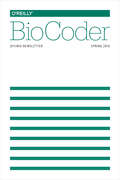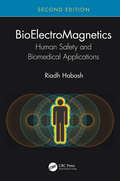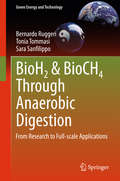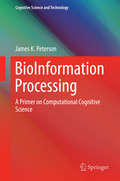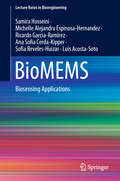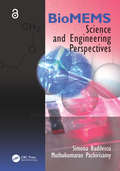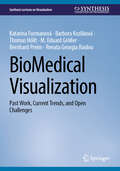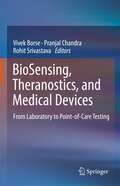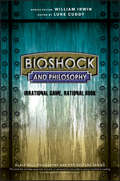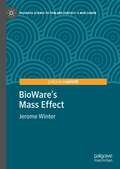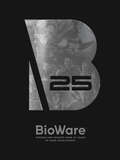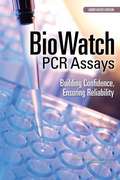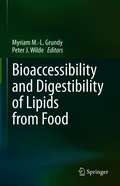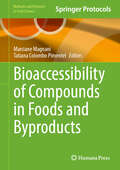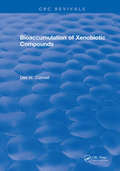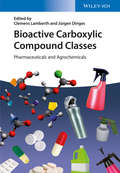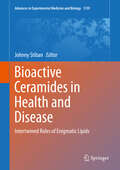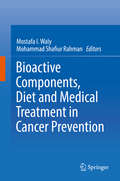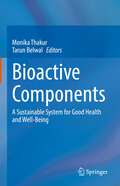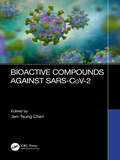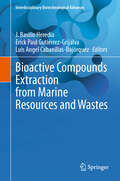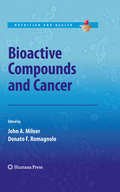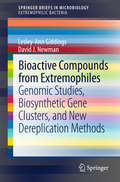- Table View
- List View
BioCoder #7: Spring 2015 (DIY/BIO Newsletter #7)
by Inc. O'Reilly MediaBioCoder is a quarterly newsletter for DIYbio, synthetic bio, and anything related. You’ll discover:Articles about interesting projects and experiments, such as the glowing plantArticles about tools, both those you buy and those you buildVisits to DIYbio laboratoriesProfiles of key people in the communityAnnouncements of events and other items of interestSafety pointers and tips about good laboratory practiceAnything that’s interesting or useful: you tell us!And BioCoder is free (for the time being), unless you want a dead-tree version. We’d like BioCoder to become self supporting (maybe even profitable), but we’ll worry about that after we’ve got a few issues under our belt.If you’d like to contribute, send email to BioCoder@oreilly.com. Tell us what you’d like to do, and we’ll get you started.
BioCoder #8: July 2015
by Inc. O'Reilly MediaBioCoder is a quarterly newsletter for DIYbio, synthetic bio, and anything related. You’ll discover:Articles about interesting projects and experiments, such as the glowing plantArticles about tools, both those you buy and those you buildVisits to DIYbio laboratoriesProfiles of key people in the communityAnnouncements of events and other items of interestSafety pointers and tips about good laboratory practiceAnything that’s interesting or useful: you tell us!And BioCoder is free (for the time being), unless you want a dead-tree version. We’d like BioCoder to become self supporting (maybe even profitable), but we’ll worry about that after we’ve got a few issues under our belt.If you’d like to contribute, send email to BioCoder@oreilly.com. Tell us what you’d like to do, and we’ll get you started.
BioElectroMagnetics: Human Safety and Biomedical Applications
by Riadh HabashThis book is an educational resource of evolving scientific knowledge in the area of bioelectromagnetics that may serve the interests of students and decision-makers, as well as society as a whole. It is distinguished by extensive descriptions of fundamental biophysical concepts and their relevance to human health. Reflecting the transdisciplinary approach from several different intellectual streams including physics, biology, epidemiology, medicine, environment, risk science, and engineering, the book is quite a venture into the battling studies to assess the latest research on health effects and biomedical applications of EM energy. This new edition of the book particularly looks at the potential threats from the emerging 5G wireless networks, which will deploy large numbers of low-powered smartphones, notebooks, tablets, radio access networks, and other transmitters. Features Introduces necessary biophysical principles of EM fields in the context of their interaction with living systems. Strengthens understanding of cutting-edge research on several major areas in the broad area of bioelectromagnetics. Presents safety standards and guidelines for human exposure to EM fields. Discusses techniques that have been developed to ensure adequate EM-thermal dosimetry required for both health effects and biomedical applications. Provides insight into the determinants of EM health risk assessment and public concerns. Includes extensive reference list at the end of each chapter to enhance further study. Riadh Habash is a special appointment professor and McLaughlin Research Chair in Electromagnetic Fields and Health at the University of Ottawa, Canada. He has been the recipient of many awards, including the National Wighton Fellowship Award, and has authored or co-authored over 90 research articles, six books, and five book chapters. His most recent books are Green Engineering in 2017 and Professional Practice in 2019 (CRC Press), with the remaining previous books targeting the area of bioelectromagnetics.
BioH2 & BioCH4 Through Anaerobic Digestion: From Research to Full-scale Applications (Green Energy and Technology)
by Bernardo Ruggeri Tonia Tommasi Sara SanfilippoThis book presents a Two-Stage Anaerobic Digestion (TSAD) technique for producing hydrogen and methane, following a step-by-step approach in order to guide readers through the experimental verification of the related hypothesis. In the first stage of AD, the reaction conditions are optimized to obtain the maximum amount of hydrogen, while in the second the liquid residue from the first phase is used as a substrate to produce fuel-methane. AD has traditionally been used to reduce the organic content of waste; this results in a biogas that is primarily constituted of CH4 and CO2. Over the last few decades, the conversion of organic matter into hydrogen by means of AD and selecting Hydrogen Producing Bacteria (HPB) has matured into a viable and sustainable technology among the pallet of H2 generation technologies. The combined bio-production of hydrogen and methane from Organic Waste Materials (OWM) is considered to be an ideal way of utilizing waste, and can increase energy efficiency (the substrate Heat Value converted into H2 and CH4 fuel) to roughly 80%, since the energy efficiency of H2-production alone (15%) is not energetically competitive. The two gas streams can be used either separately or in combination (Hytane®), be supplied as civilian gas or used for transportation purposes. All the aspects of this sustainable technology are taken into account, from the basic biochemical implications to engineering aspects, establishing the design criteria and the scale-up procedures for full-scale application. The sustainability of the TSAD method is assessed by applying EROI (Energy Return On Investment) and EPT (Energy Payback Time) criteria, and both the general approach and application to the field of Anaerobic Digestion are illustrated.
BioInformation Processing: A Primer on Computational Cognitive Science (Cognitive Science and Technology)
by James K. PetersonThis book shows how mathematics, computer science and science can be usefully and seamlessly intertwined. It begins with a general model of cognitive processes in a network of computational nodes, such as neurons, using a variety of tools from mathematics, computational science and neurobiology. It then moves on to solve the diffusion model from a low-level random walk point of view. It also demonstrates how this idea can be used in a new approach to solving the cable equation, in order to better understand the neural computation approximations. It introduces specialized data for emotional content, which allows a brain model to be built using MatLab tools, and also highlights a simple model of cognitive dysfunction.
BioMEMS: Biosensing Applications (Lecture Notes in Bioengineering)
by Samira Hosseini Michelle Alejandra Espinosa-Hernandez Ricardo Garcia-Ramirez Ana Sofia Cerda-Kipper Sofia Reveles-Huizar Luis Acosta-SotoThis book highlights the latest advances in bioMEMS for biosensing applications. It comprehensively reviews different detection methods, including colorimetric, fluorescence, luminescence, bioluminescence, chemiluminescence, biochemiluminescence, and electrochemiluminescence, and presents various bioMEMS for each, together with recent examples. The book also offers an overview of the history of BioMEMS and the design and manufacture of the first bioMEMS-based devices.
BioMEMS: Science and Engineering Perspectives
by Simona Badilescu Muthukumaran PackirisamyAs technological advancements widen the scope of applications for biomicroelectromechanical systems (BioMEMS or biomicrosystems), the field continues to have an impact on many aspects of life science operations and functionalities. Because BioMEMS research and development require the input of experts who use different technical languages and come f
BioMedical Visualization: Past Work, Current Trends, and Open Challenges (Synthesis Lectures on Visualization)
by Bernhard Preim Katarína Furmanová Barbora Kozlíková Thomas Höllt M. Eduard Gröller Renata Georgia RaidouThis book provides an overview of the many visualization strategies that have been proposed in recent decades for solving problems within the disciplines of medicine and biology. It also evaluates which visualization techniques applied to various areas of biomedicine have been the most impactful and which challenges can be considered solved using visualization. The topics covered in this book include visualization research in omics, interaction networks and pathways, biological structures, tumor diagnosis and treatment, vasculature, brain, surgery, educational contexts, therapy and rehabilitation, electronic health records, and public health. One chapter is dedicated to general visualization techniques commonly used for biomedical data, such as surface and volume rendering, as well as abstract and illustrative approaches. For each of these areas, the past and present research trends are discussed, highlighting the influential works. Furthermore, the book explains how research is affected by developments in technology, data availability, and domain practice. Individual sections also summarize the typical target users, the nature of the data, and the typical tasks addressed in the given domain. With a uniquely broad scope, the book identifies research trends in biomedical visualization using a manually curated and searchable repository of more than 3,800 publications. The resultant trends are further categorized according to the application field and using natural language processing. The book also utilizes 16 interviews conducted with researchers in the field of biomedical visualization for the purpose of soliciting their opinions regarding the evolution and trends in the domain. The book handles these topics in a concise manner to help readers orient themselves in the already mature and diverse field of biomedical visualization without overwhelming them with technical details. As such, the book can help young researchers to become familiar with past challenges and identify future ones. For more senior researchers, it can serve as an insightful overview of the research field and the direction in which it is heading.
BioSensing, Theranostics, and Medical Devices: From Laboratory to Point-of-Care Testing
by Rohit Srivastava Pranjal Chandra Vivek BorseThis book provides up-to-date information on the prototypes used to develop medical devices and explains the principles of biosensing and theranostics. It also discusses the development of biosensor and application-orientated design of medical devices. In addition to summarizing the clinical validation of the developed techniques and devices and the regulatory steps involved in their commercialization, the book highlights the latest research and translational technologies toward the development of point-of-care devices in the health care. Lastly, it explores the current opportunities, challenges and provides troubleshooting on the use of biosensors in precision medicine. The book is helpful for researchers and medical professionals working in the field of clinical theranostics, and medical-device development wanting to gain a better understanding into the principles and processes involved in the development of biosensors.
BioShock and Philosophy
by William Irwin Luke CuddyConsidered a sign of the 'coming of age' of video games as an artistic medium, the award-winning BioShock franchise covers vast philosophical ground. BioShock and Philosophy: Irrational Game, Rational Book presents expert reflections by philosophers (and Bioshock connoisseurs) on this critically acclaimed and immersive fan-favorite. Reveals the philosophical questions raised through the artistic complexity, compelling characters and absorbing plots of this ground-breaking first-person shooter (FPS) Explores what BioShock teaches the gamer about gaming, and the aesthetics of video game storytelling Addresses a wide array of topics including Marxism, propaganda, human enhancement technologies, political decision-making, free will, morality, feminism, transworld individuality, and vending machines in the dystopian society of Rapture Considers visionary game developer Ken Levine's depiction of Ayn Rand's philosophy, as well as the theories of Aristotle, de Beauvoir, Dewey, Leibniz, Marx, Plato, and others from the Hall of Philosophical Heroes
BioTransplant, Inc.: Initial Public Offering, January 1996
by Paul A. Gompers Alexander TsaiExamines the decision to go public. BioTransplant is an early stage biotechnology company that must decide how to finance its research and development. The pros and cons of public offerings are analyzed versus alternative financing sources.
BioWare's Mass Effect (Palgrave Science Fiction and Fantasy: A New Canon)
by Jerome WinterThe videogame series Mass Effect is a remarkable rarity not only for being an original science-fictional franchise of recent vintage that has risen to such prominent commercial and critical success in popular culture but also for pushing the canonical boundaries of how science fiction as a genre will be experienced and understood in the future. This book analyzes the significance of the game for an understanding of the evolving SF genre and articulates an explanatory framework to limn its landmark reception in videogame history. This book both synthesizes the burgeoning body of scholarship on Mass Effect for a readership unfamiliar with either the game or the critical conversation on its salient importance, while simultaneously, for readers already invested in the science-fiction and videogame scholarship, mounting an extended inquiry as to why Mass Effect has served as such a representative milestone in videogame and genre history. The book should appeal to veteran science-fiction and videogame scholars and students as well as a wide variety of fans, consumers, gamers, and general readers.
BioWare: Stories and Secrets from 25 Years of Game Development
by BiowareFrom the BioWare's isometric role-playing roots to its intense space operas and living worlds, chart the legendary game studio's first 25 years in this massive retrospective.BioWare - Stories and Secrets from 25 Years of Game Development puts you in the room during key moments in BioWare's history, with never-before-seen art and photos anchored by candid stories from developers past and present. See what it took to make games in those wild early days. Pore over details of secret, cancelled projects. Discover the genesis of beloved characters and games. Presented and designed by Dark Horse Books, this tribute to BioWare's legacy is a must-have for any fan of the best stories you can play.
BioWatch PCR Assays: Building Confidence, Ensuring Reliability; Abbreviated Version
by Committee on PCR Standards for the BioWatch ProgramBioWatch is an air monitoring system deployed in jurisdictions around the country with the goal of detecting the presence of certain high risk pathogenic microorganisms. It relies on a network of federal and nonfederal collaborative relationships to be successful, and is one part of a larger array of disease surveillance, intelligence-gathering, and biomonitoring activities in support of public safety and health. The assays used in the BioWatch system to detect the presence of pathogens in collected samples rely on the technique of polymerase chain reaction (PCR) to sensitively and specifically amplify target nucleic acid sequences. "BioWatch PCR Assays" evaluates and provides guidance on appropriate standards for the validation and verification of PCR tests and assays in order to ensure that adequate performance data are available to public health and other key decision makers with a sufficient confidence level to facilitate the public health response to a BioWatch Actionable Response. This report discusses principles of performance standards, reviews information from several existing guidance documents and standards that might be applicable to BioWatch, and discusses assay testing efforts that have occurred or are ongoing. BioWatch PCR Assays provides recommendations on general principles and approaches for a performance standard and validation framework to meet BioWatch's mission. The report also considers how developments in technology, particularly in multiplex PCR and next-generation sequencing, can contribute to the ability of the BioWatch program to meet current and future challenges. This report has been determined to contain information exempt from disclosure under 5 U. S. C. 552(b). Section 15 of the Federal Advisory Committee Act provides that the National Academies shall make its final report available to the public unless the National Academies determines that the report would disclose matters described in one or more of the exemption provisions under the Freedom of Information Act (FOIA). In such case, the National Academies "shall make public an abbreviated version of the report that does not disclose those matters. " This unrestricted, abbreviated version of the report represents, in so far as possible, the committee's findings, recommendations, and other substantive material without disclosing materials described in 5 U. S. C. 552(b).
Bioaccessibility and Digestibility of Lipids from Food
by Myriam M.-L. Grundy Peter J. WildeThe structure of a food influences the way it is transformed during processing and digestion. This in turn has an impact on nutrient bioaccessibility (release) and digestibility, and subsequently on the physiological response and health of the individual who consumes that food. Although evidence exists on the health benefits associated with the inclusion of certain lipid-rich foods (e.g. nuts, dairy products and fish) in the diet, the mechanisms that explain the physiological effects and the long-term benefits are not well understood. Lipids in themselves have many beneficial health effects: they are a source of energy and essential fatty acids, they are structural components of cell membranes, they are required to solubilise fat soluble compounds, and they serve as precursors of hormones. In addition, the overall structure of the food containing the lipids plays a crucial role in determining health benefits, notably by influencing lipid bioaccessibility and digestibility. Bioaccessibility and digestibility of lipids from food uniquely focuses on the physico-chemical properties of lipids and lipid rich food, as well as the subsequent effects on human health. Chapters from experts in food digestion examine food structure at both the macro- and micro- levels, covering lipids from plant and animal food products. The editors have developed the book for dietitians, nutritionists, and food scientists. Clinicians and other health professionals, educators in nutrition, and others working in the food industry will also find the material relevant.
Bioaccessibility of Compounds in Foods and Byproducts (Methods and Protocols in Food Science)
by Marciane Magnani Tatiana Colombo PimentelThis volume provides detailed and comprehensive descriptions of the methodologies and procedures used to evaluate bioaccessibility in different food compounds. Chapters focus on phenolics, minerals, carotenoids, fatty acids, and other bioactive molecules. Written in the format of the Methods and Protocols in Food Science series, chapters list necessary materials and methods for readily reproducible protocols. Authoritative and cutting-edge, Bioaccessibility of Compounds in Foods and Byproducts aims to be comprehensive guide for researchers in the field.
Bioaccumulation of Xenobiotic Compounds
by Des W. ConnellOne of the very few - if not only - books written exclusively related to this topic. This book comprehensively outlines the principles governing the accumulation of chemicals from the environment by organisms. Packed with tables and diagrams, this work reviews the experimental data available on both terrestrial and aquatic systems. It describes methods which are used to predict bioaccumulation of chemicals from their physicochemical properties. It also reviews environmental and other factors influencing bioaccumulation. This text also includes previously unpublished theoretical explanations of several bioaccumulation processes, including food chain biomagnification. Information in this exceptional volume is useful to government officials involved with environmental management, chemists, biologists, consultants working with chemical waste control, researchers, and graduate students.
Bioactive Carboxylic Compound Classes: Pharmaceuticals and Agrochemicals
by Jürgen Dinges Clemens LamberthFollowing the successful and proven concept used in "Bioactive Heterocyclic Compound Classes" by the same editors, this book is the first to present approved pharmaceutical and agrochemical compounds classified by their carboxylic acid functionality in one handy volume. Each of the around 40 chapters describes one or two typical syntheses of a specific compound class and provides concise information on the history of development, mode of action, biological activity and field of application, as well as structure-activity relationships. In addition, similarities and differences between pharmaceuticals and agrochemicals are discussed in the introduction. Written by a team of experts in the field, this is a useful reference for researchers in academia and chemical or pharmaceutical companies working in the field of total synthesis and natural product chemistry, drug development, and crop protection research.
Bioactive Ceramides in Health and Disease: Intertwined Roles of Enigmatic Lipids (Advances in Experimental Medicine and Biology #1159)
by Johnny StibanThis book is about the various roles of bioactive ceramides and other sphingolipids in cellular biology. The enigmatic biophysical and biochemical properties of ceramides and their propensity to influence membranes whether as rafts or protein-permeable channels are heavily discussed. Metabolism of ceramides and their metabolites is also focused with ceramide synthase family of proteins being a target of extensive review. Ceramide 1-phosphate and other sphingolipids are also presented in cellular physiology and pathophysiology. Prokaryotic origins of mitochondria at the level of membranes and the occurrence of apoptosis in bacteria are presented. Many aspects of ceramide and sphingolipid biology are addressed in this book. Its focus is the metabolism of ceramide in normal and diseased states and the biophysical and biochemical mechanisms governing the bioactivity of these molecules. Sphingolipid research has surged over the past thirty years and this book gathers the recent findings of various aspects of sphingolipid biochemistry. World-renowned scientists from the field of lipid biology, specifically sphingolipid biochemistry, were gathered to write this book. Scholars from most continents of the globe committed to write diligently about their expertise and the newest findings in the relevant fields. This book came to fruition after almost a year and a half of laborious preparation and diligent writings. This book is targeted to the experienced reader who is looking to read about the various aspects of bioactive ceramide signaling, as well as to the newcomer into the field, as the topics are explained in concise yet very informative manner. The authors and editor wish all readers a pleasant time reading this volume, and are adamant that this book will meet all expectations.
Bioactive Components, Diet and Medical Treatment in Cancer Prevention
by Mohammad Shafiur Rahman Mostafa I. WalyThe high rate of urbanization and a steady increase in per capita income has improved the socio-economic status of people all over the world. This has resulted in drastic changes in their lifestyle and food consumption patterns, where traditional foods are being replaced with more ready-made junk foods with few servings of fresh vegetables and fruits. It has been postulated that industrialization has caused change in food choice, dietary pattern modification and resulted in a sedentary lifestyle. In addition, contaminated foods with unsafe microbes and chemical hazards are increasing. All of these events have resulted in an increased risk of cancer, the leading cause of mortality and morbidity worldwide.This book will provide a basic understanding of cancer, its risk factors, preventive measures, and possible treatments currently available, as well as identifying the different dietary factors that might synergize with a sedentary lifestyle in the etiology of cancer, and its prevention measure.
Bioactive Components: A Sustainable System for Good Health and Well-Being
by Monika Thakur Tarun BelwalThis book compiles updated information about the role and health benefits of various bioactives in food. Different chapters are contributed by academicians, food scientists, technologists, and medical practitioners. The book addresses both theoretical and applied aspects of bioactive components and provides exhaustive knowledge about bioactive components. It comprises 27 chapters organized into 4 major sections covering topics in food science and technology, functional foods, and nutraceuticals. It provides perspectives for innovation, sources, applications, and sustainability in bioactive component research. The first section starts with introduction of bioactive components consisting of seven different chapters primarily focusing on the bioactive components and their sources with respective health benefits. The second section, comprising five different chapters, deals with different technological trends, regulations, and safety aspects of bioactive components. With eight chapters, the third section covers the role of bioactive components in human health and the role of functional foods in combating various health-related issues. The fourth section reviews functional foods through six chapters that cover the use of bioactive components in various food products. The book will prove useful to advanced food technology graduate and undergraduate students and research scholars, practicing food technologists in food and related industries, entrepreneurs, food-pharma researchers, and other scientists seeking information about smart and sustainable processes as well as information needed to design and develop these processes.
Bioactive Compounds Against SARS-CoV-2
by Jen-Tsung ChenCoronaviruses can cause illness, severe disease, and death; for example, Middle East respiratory syndrome (MERS), severe acute respiratory syndrome (SARS), and COVID-19. Vaccine development and antiviral drugs are challenged by the propensity for viral mutations allowing these viruses to evade such therapies. There are a number of bioactive compounds from natural sources, which can exert health benefits and act as antiviral therapies such as anti-inflammation, antioxidative stress, and immune regulation. This book summarizes research on the potential efficacy and underlying mechanisms of bioactive compounds and traditional medicines against SARS-CoV-2. Key Features Summarizes the potential benefits of bioactive therapies for coronaviruses Focuses on COVID-19, but also covers MERS and SARS Provides alternatives to vaccines and other antiviral drugs whose efficacy is reduced by viral mutations Relevant for clinicians and public health officials
Bioactive Compounds Extraction from Marine Resources and Wastes (Interdisciplinary Biotechnological Advances)
by J. Basilio Heredia Erick Paul Gutiérrez-Grijalva Luis Angel Cabanillas-BojórquezThis book provides information about the principal biotechnological strategies (enzyme-assisted extraction, liquid fermentation, and solid-state fermentation) used for the bioactive compounds (bioactive peptides, carotenoids, phenolic acids, polyunsaturated fatty acids, vitamins, and minerals, among others) extraction from the marine resource (marine animals, microalgae, seaweed, among others) and wastes (crustaceans, fish, and others). This book also highlights the importance of bioactive compounds in marine resources and wastes and the perspectives for a potential industrial application. This book is oriented to researchers related to marine resources and marine wastes, who apply their knowledge in the innovation of the extraction and application of bioactive compounds from these sources. Moreover, this book will also provide knowledge and areas of opportunity for entrepreneurs, different industries, and the development of new products that could be used in the overall improvement of different areas such as human health.
Bioactive Compounds and Cancer (Nutrition and Health)
by John A. Milner Donato F. RomagnoloBecause of the wealth of new information generated by the scientific community during the last decade on the role of nutrition on cancer risk, this book provides a forum for presentation and discussion of recent scientific data and highlights a set of dietary recommendations. Bioactive Compounds and Cancer presents chapters that highlight laboratory and clinical findings on how selected nutrients function as signaling molecules and, as such, influence cellular behavior and cancer predisposition. This important compendium focuses on understanding the role of nutrition in cancer biology, the molecular action of bioactive food components and xenobiotics on cancer risk, the role of dietary components in cancer prevention and/or treatment, and nutrition education with the most up to date dietary recommendations that may reduce cancer risk. This volume will be of interest to specialized health professionals, clinicians, nurses, basic and clinical researchers, graduate students, and health officials of public and private organizations.
Bioactive Compounds from Extremophiles: Genomic Studies, Biosynthetic Gene Clusters, and New Dereplication Methods (SpringerBriefs in Microbiology)
by Lesley-Ann Giddings David J. NewmanThis SpringerBrief sheds new light on bioactive materials from extremophiles with the focus on the biosynthesis processes and related genomics. It deals with all aspects of the chemical compounds produced by organisms living under extreme conditions that may have potential as drugs or lead to novel drugs for human use.
